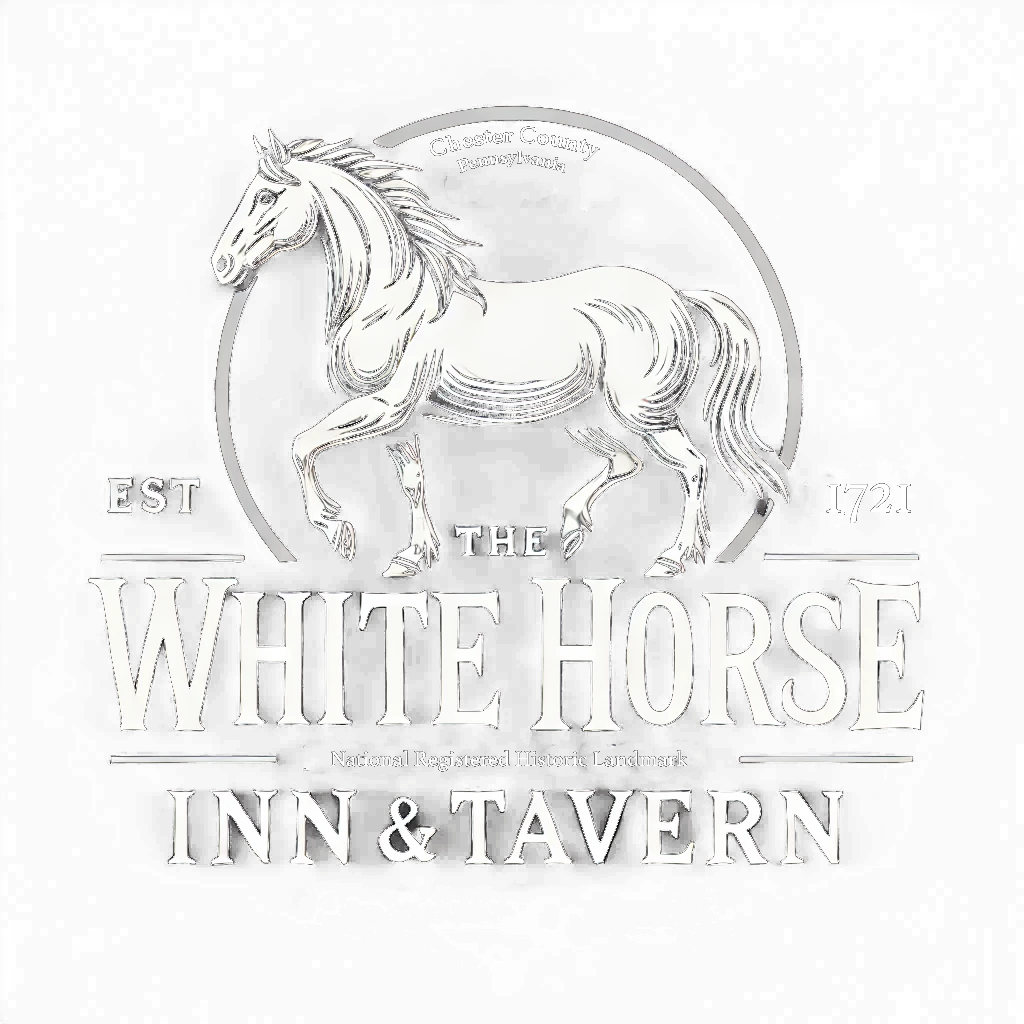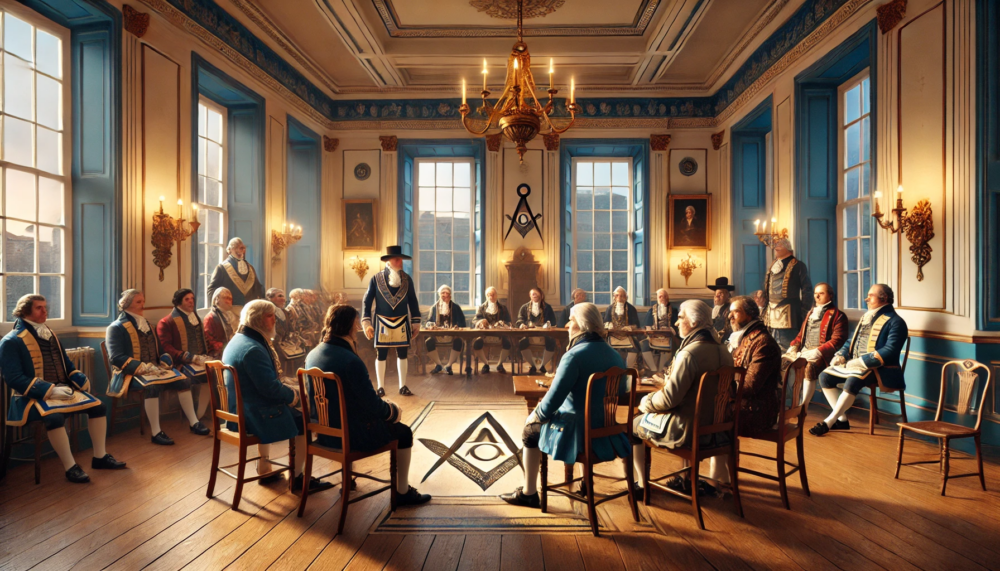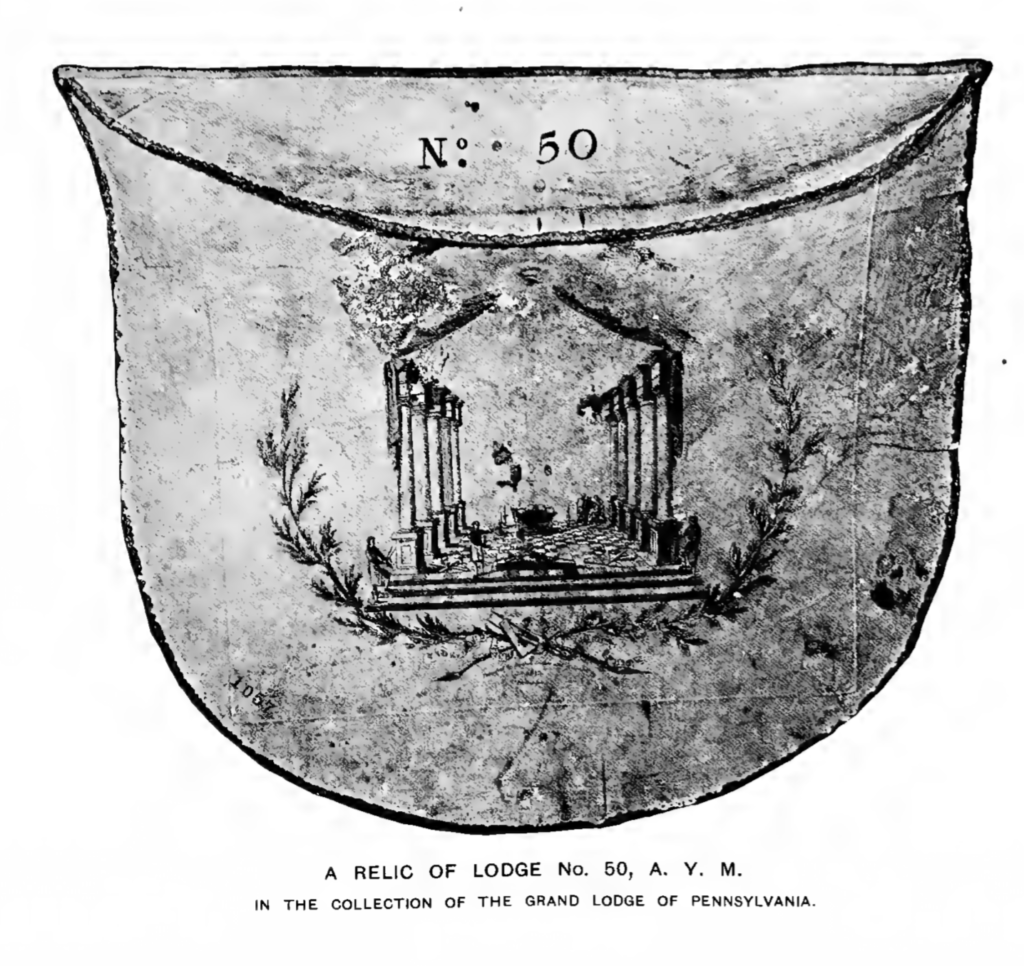The history of Freemasons in Chester County starts with Philadelphia Lodge 2, to Valley Force Lodge 8, to the “first Lodge to meet in” Chester Lodge No. 50. Lodge 50 met at the “Sign of the White Horse” from 1790 to 1807. Arthur Rice, one of the founding members of Lodge 50, was also the owner of the White Horse Tavern starting in 1787.
Charter Members
The Charter Members of Lodge No. 50, all of whom had
been Members of Lodge No. 8, were
- Bro. John Christie–Captain of the 5’h Battalion of the Pennsylvania Line
- John Davis (Dr.)
- Ezekiel Howell
- Persifer Frazer–a Revolution Era farmer-turned-soldier-turned-judge, and namesake of Frazer, Pa.
- Cromwell Pierce–Father of Col. Cromwell Pierce well-known in Chester County history.
- Thomas Cummins
- John Smith–officer in the infantry during the Revolution.
- John Bartholomew–served as Major of the Chester County regiment of the Flying Camp in 1775, and afterward attained the rank of Colonel and Brigadier General of militia. He was also a justice of the peace
- Thomas Boss
- John Davis–son-in-law of john S. Morton, one of the Signers of the Declaration of Independence
- Joseph McClellan
- Arthur Rice — Owner of the White Horse Inn when new addition to the Inn was built and used for meetings.
Masters of the Lodge from 1800-1807:
- December 1801, Bro. Marmaduke Pearce
- December 1802, Bro. John Rowland
- June 1803, Bro. Cromwell Pearce
- December 1803, Bro. John G. Bull
- December 1804, Bro. John Lindsey
- December 1805, Bro. Joseph Pearce
- June 1806, Bro. Isaac Darlington
Members of Lodge while meeting at the “Sign of the White Horse”
- John Christie A. 1790, Nov. 6.
- John Davis A. 1790, Nov. 6.
- Ezekiil Howell A. 1790, Nov. 6.
- Persifer Frazer A. 1790, Nov. 6.
- Cromwell Pierce A.. 1790, Nov. 6.
- Thomas Cummins A. 1790, Nov. 6.
- John Smith A. 1790, Nov. 6.
- John Bartholomew A. 1790, Nov. 6.
- Thomas Ross A. 1790, Nov. 6.
- John Davis A. 1790, Nov. 6.
- Joseph MeClelan A. 1790, Nov. 6.
- Arthur Rice A. 1790, Nov. 6.
- Charles Dilworth I. 1791, Mar. 12.
- James Bones A. 1791, Sep. 10.
- John Quinn I. 1792, Mar. 10.
- Richard Robinson I. 1792, Apr. 14.
- Jacob Humphreys A. 1793, Oct. 12.
- John H. Coats I. 1793, Mar. 9.
- Dennis Wheelen I. 1793, Dec. 14.
- William Davis I. 1794, Jan. 11.
- Charles Willing I. 1794, May 10.
- Daniel Masey I. 1794, Aug. 9.
- William Davis I. 1794, Dec. 13.
- Samuel Downing I. 1795, Apr. 11.
- Joseph Hemphill I. 1795, May 9.
- Abel Thomas I. 1795, Sep. 12.
- Cromwell Pierce I. 1795, Sep. 12.
- WIlls Hemphill I. 1795, Nov. 14.
- John G. Bull I. 1795, Nov. 14.
- William Worthington I. 1796, Aug. 13.
- John Worthington I. 1796, Sep. 10.
- Robert Frazer I. 1796, Oct. 8.
- John Smith I. 1796, Dec. 10.
- Evan Pugh I. 1797, Feb. 11.
- Jesse Roberts I. 1797, Feb. 11.
- Evan Phillips I. 1797, Apr. 8.
- John Shippen I. 1797, Mar. 11.
- William McWilliam I. 1793, Feb. 10.
- Edward Pearce I. 1798, Sep. 10.
- Thomas Taylor I. 1799, May 11.
- Washington Hannum I. 1799, Aug. 10.
- Marmaduke Pearce I. 1799, Aug. 10.
- Samuel Davis I. 1799, Dec. 14.
- John Robinson I. 1800, Mar. 8.
- John Roland I. 1800, Nov. 8.
- Daniel Crousel I. 1801, Feb. 14.
- Thomas Lindsey I. 1801, Mar. 14.
- Jacob Neiler I. 1801, May 9.
- Joseph Pearce I. 1801, Oct. 10.
- Stephen Bowers I. 1801, Nov. 14.
- Thomas Parke I. 1801, Dee. 12.
- John Taylor I. 1802, Apr. 10.
- John Bowling I. 1802, Aug. 14.
- James D. Bernard I. 1802, Sep. 11.
- Richard Budder I. 1802, Oct. 9.
- John Lindsey A. 1802, Feb. 13,
- David Tearsbey I. 1803, Jan. 8.
- Joseph Vernon.
- George Norman I. 1804, Nov. 10.
- Moses McCloskey I. 1805, Feb. 9.
- Daniel Hiester, Esq I. 1805, May 11.
- Isaac Darlington, Esq I. 1805, May 11.
- John E. Porter, Esq I. 1805, June 24.
- Ephraim BufiBngton I. 1806, April 12.
- Samuel Osborne I. 1806, May 10.
- Jacob Righter I. 1806, Sept. 13.
- Joshua Baldwin I. 1806, Dec. 13.
History From Lodge no. 8 to Lodge no. 50
Lodge No. 8 was the first country Lodge warranted in Pennsylvania and from the outbreak of the Revolution was a patriotic Lodge. It appears that most, if not all, of the candidates for admission to this Lodge, and the visitors, had at some time been connected with the American army. Little is known of the early history of this Lodge; however, the Lodge was an active one who had upon its rolls many who took an active part in the Revolutionary struggle, as well as Masonic affairs. During 1777 and 1778 the Brethren of Lodge No. 8 became scattered and it became difficult to hold regular meetings. Control of various parts of Chester County changed hands between the Continental Army and the British, depending on who held the ground at any given time during the war.
Col john Bull a naive of Providence Township, Montgomery County, was a miller by trade. He was one of the twelve members .from Philadelphia County in the Provincial Convention of 1775, also of the Convention that framed the Constitution of the State in 1776. He was confirmed a Justice of the Peace in 1778. Tradition states that Brother Bull is the Brother who nominated General Washington as General Grand Master of the United States, in the Grand Lodge of Pennsylvania on January 13, 1780.
Also of note, records indicate the existence, during the period of the Revolutionary War, of a Pennsylvania Lodge #19, which was a military Lodge working under the jurisdiction of the Provincial Grand Lodge of Pennsylvania. This lodge was associated with the artillery of the “Pennsylvania Line” of the Continental Army. The indications are that this lodge met as occasion demanded from the Carolinas to New England as the army moved from campaign to campaign.
It is believed that several frequent visitors of Lodge No. 8, who were from this area and later become charter members of Lodge No. 50, were members of, or at least associated with, this old military Lodge.
Lodge No.8 continued to meet throughout the 1780’s at a variety of locations including Valley Forge, “Peter Holstein’s” at the Swedesford below Norristown, Hannah Thompson’s Inn above Norristown, the James Page residence, and, at least once, at the Court House in Norristown. On June 15, 1784 the Lodge was opened in due form and proceeded to the installation of officers, after which the following petition was read:
“To, the Worshipful Master of Lodge No. 8. The Petition of the Subscribers Members of Different Warranted lodges Respectfully Sheweth That your Petitioners finding it Inconvenient to attend the Particular Lodges to which they Belong are Desirous to become members of Lodge No. 8 if a Dispensation can be obtained from the Right Worshipful the Grand Lodge to Hold said Lodge No. 8 in Chester County in the Townships of Tredyffrin & East Whitehead to meet successively in Philada. & Chester Counties. June 15, I 784. “Signed: John Jarvis, No.2; ]no. Bartholomew, No.3; john Christie, No. 29; john Webster, No.19; john Smith, No.3; Ezekiel Howell, N York Traveling lodge; Caleb North, No.29; and Alex’r McCaraker, No.3.
This petition was approved and ordered chat they be admitted upon their producing Certificates from the Lodges of which they are members. On March 25, 1788 an extra meeting of Lodge No. 8 was held in Norristown when a petition for membership was received from Chester County resident John Hannum. Brother Hannum was Entered on March 25, 1788, Passed on December 24, 1788, and Raised on December 25, 1788. If you are wondering why you sometimes see members accepted and Entered on the same date and then receive two degrees in two days, remember that travel in those days was extremely difficult compared to today and required a great deal of time and effort.
Col. john Hannum, Esq. was a prominent citizen of Chester County. He was present at the Battle of Brandywine and with Wayne on the night of the Paoli Massacre. After the war he served as Register of Wills and Recorder of Deeds of Chester County. He died February 7, 1799.
The last representation of the old Colonial Lodge was at the communication held August 16, 1790. Why Lodge No. 8 closed its labors cannot be told, as no record has been found. However, the members living within the bounds of Chester County were unwilling to be without a Lodge for long.
After Lodge No. 8 had virtually disbanded, in the year 1789 a number of the Brethren living in Chester County, and who had been companions in arms during the War for Independence. made application for a new Warrant. Their petition was presumed at the Quarterly Communication, December 6, 1790, and, upon the prayer of their petition being granted, Lodge No. 50 was born.
A facsimile copy of the original petition for Warrant No. 50 can be found in Volume II, “Old Masonic Lodges of Pennsylvania” by Jullius F Sachse, Litt.D., between pages 296 and 297. The warrant was made out in the names of John Smith, Worshipful Master; John Bartholomew, Senior Warden; and John Christie, Junior Warden. The original petition was signed by John Smith, John Bartholomew, John Christie, Dr. John Davis, -Persifer Frazer, Cromwell Pearce, Arthur Rice, and John Davis (2). Ezekial Howell, Joseph McClellan, Thomas Cummins, and Thomas Ross were also considered to be charter members, however their signatures are not on the original petition. “All were men well known and of much influence in the area.”
Bro. John Smith, originally a member of Lodge No. 3, joined Lodge No. 8, June 15, 1784. Bro. Smith was a Past Master and served rJS rm officer in the infantry during the Revolution.
Bro. John Bartholomew was a native of the great Chester Valley, born 1748. His farm was in East Whiteland Township. He served as Major of the Chester County regiment of the Flying Camp in 1775, and afterward attained the rank of Colonel and Brigadier General of militia. He was also a justice of the peace and one of the leading members of the Great Valley Baptist Church. He died January 24, 1814, in the sixty-sixth year of his age.
Bro. Christie was a farmer member of Lodge No. 29 and affiliated with Lodge No. 8 on June 15, 1784. He was a Captain of the 5’h Battalion of the Pennsylvania Line where he served until the end of the war. He later transferred to the 3rd Pennsylvania and served until 1783.
Bro. Cromwell Pierce, a veteran of the French and Indian War, was born in Oreland in 1732, and raised on the farm which was the scene of the Paoli Massacre, September 1777. He was commissioned Lieutenant in the Pennsylvania Regiment of Foot under Gen. Forbes, and built a fort at Shamokin, Pa. In the patriot army he was appointed Major, May 6, 1777, and on May 20, 1779, Colonel of the Fifth Battalion of Chester County Militia. He died August 4, 1794, and is buried in the family row in the yard at St. Peter’s Great Valley Episcopal Church.
Bro. John Davis (2) was a Native of Tredyffrin, and a son-in-law of john S .. Morton, one of the Signers of the Declaration of Independence. He died near Paoli, July 1 O, 1827, aged 74 years, and was buried in the ground of the Great Valley Presbyterian Church.
Lodge No. 50 was considered the virtual successor to the old Provincial Lodge No. 8, whose original place of meeting was warranted to be within a radius of five miles of Valley Forge. Erected at The “Sign of the White Horse” in East Whiteland, Chester County, a landmark on the old Lancaster road-according to the old distance tables, Lodge No. 50 was 26 miles, l quarter and 18 perches-west of the Court House at Second and Market Streets, in Philadelphia. from which, at that period, all distances were reckoned.
The first candidate, who was entered, passed and raised, within the portals of Lodge No. 50, was Bro. Charles Dilworth, March 12, 1791. Charles Dilworth was the tavern keeper at Dilworthtown, Birmingham Township, Chester County, and in 1791 was the high sheriff of Chester County.
From 1790 until 1806 the Lodge met on the second Saturday of each month, except July and August, in the tavern known as the “Sign of the ‘White Horse” when, with the “new Lancaster Road” (Lincoln Highway) bypassing their place of meeting and with the county seat being recently moved to West Chester, they requested permission of the Grand Lodge to move their meeting place to West Chester. Permission was granted on January 5, 1807 and the Lodge met for many years in a room over the Prothonotary’s Office in a building on the southeast corner of the present Court House yard.
Quoted text above taken from:
Over 150 Years in West Chester and Chester County


